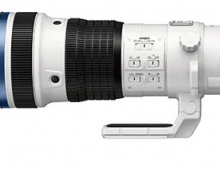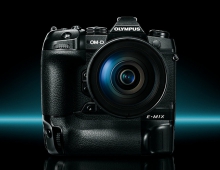
Olympus Launches the OM-D E-M5 Mark III Camera
A few days after the 100th Anniversary of the company’s founding, Olympus today launched the OM-D E-M5 Mark III.
Designed for photography enthusiasts and semi-professionals, the E-M5 Mark III features a weather-sealed construction, high- performance autofocus capabilities and a powerful image stabilization system along.
At up to half the size and weight of other interchangeable lens systems, Olympus’ biggest advantage is mobility thanks to the compact, lightweight camera system, including lenses.
The E-M5 Mark III boasts a combination of the 20.4 Megapixel Live MOS sensor and the high-speed TruePic VIII image processor known from Olympus’ flagship model OM-D E-M1 Mark II as well as a new compact in- body 5-axis image stabilization system. When paired with high-resolution M.Zuiko lenses, the E-M5 Mark III is capable of capturing images with minimal noise even at high ISO settings.
The camera body is dust-, splash-, and freezeproof. Olympus’ SSWF (Super Sonic Wave Filter) sensor-cleaning technology reduces the amount of dust and dirt that may end up in photos or video by vibrating the image sensor filter 30,000 times per second when turning the camera on.
The design of the OM-D E-M5 Mark III body is reminiscent of the original OM-D and was further improved for operability by adding thumb rests on the back with an enlarged grip.
The OM-D E-M5 Mark III is equipped with Olympus’ renowned 121-point all cross-type On-chip Phase Detection autofocus (AF) system with different single and group target options. Unlike the autofocus in DSLR cameras, there is no degradation in AF precision when using a fast lens. The E-M5 Mark III offers high-precision, high-speed focusing from the maximum aperture setting of all M.Zuiko lenses regardless of subject patterns. The algorithm has been further improved over previous models, preventing the focus from unexpected jumping to the background even in mixed perspective scenes with near and far subjects.
To capture subjects with intense movements – such as in sports or wildlife photography – the E-M5 Mark III allows up to 10 fps high-speed sequential shooting in AF/AE tracking. The moving subject tracking algorithm utilizes AF information from both Live View and recorded images to enable quick tracking of unpredictable subject movement and changes in subject speed. The AF of the OM-D E-M5 Mark III brings out the full potential of the distinguished MSC (Movie & Still Compatible) mechanism enabling fast and quiet autofocusing in M.Zuiko lenses.
Based on camera shake information obtained from the high-sensitivity gyro sensor and image analysis, the TruePic VIII image processor controls the IS unit to enable up to 5.5 shutter speed steps of compensation performance. Olympus’ in-body image stabilization system ensures stabilization with all lenses attached to the OM-D E-M5 Mark III. In addition to angular and shift blur, roll blur is corrected to optimally support handheld shooting. By synchronizing the in-lens IS of supported lenses3 with sync IS, the OM-D E-M5 Mark III is able to deliver an even better image stabilization performance of up to approximately 6.5 shutter speed steps of compensation.
The OM-D E-M5 Mark III is equipped with Live Composite, which overlaps multiple shots recorded at the same shutter speed and composites only the sections that are brighter for capturing light trails. This feature helps prevent the common phenomenon of images that are too bright when shooting long exposures. Users can check the progress of light trails in real-time using Live View.
Pro Capture mode makes it possible to capture scenes that are difficult to time for the photographer, such as a bird taking flight. Pro Capture starts shooting the moment the shutter release button is pressed down halfway, with a buffer that can be set to capture up to 14 frames in full resolution. The moment the button is pressed down fully, the frames are available to select from retroactively on top of the images recorded while pressing the button.
Tripod High Res Shot shifts the image sensor in 0.5-pixel increments while capturing 8 sequential shots, which are then merged into a single 50M equivalent high-resolution photo. This feature is perfect for landscape shots, product photography in a studio, and other situations that require high- definition images.
Focus Bracketing can capture up to 999 shots with a single shutter activation while shifting the focal position slightly between each shot. The amount of focal shifts can be selected from 10 levels, and recorded images can be combined into a single image using the Olympus Workspace image editing software. It is possible to create a single image with a depth of field that cannot be obtained simply by stopping down the aperture.
The Focus Stacking feature automatically composites images on the E-M5 Mark III. Eight photos with different focal positions are composited on the camera for a photo with a greater depth of field that is in focus from the foreground to the background.
Information from the On-chip Phase Detection AF sensor is used for optimal focusing when recording video. With this, users can record 4K 30P high- definition video. Combining 5-axis IS with electronic stabilization makes it possible to record stable video with minimal camera shake.
The E-M5 Mark III features a 2.36 million-dot OLED panel and an EVF (electronic viewfinder) system for minimal distortion up to the edges of the screen. The long eyepoint makes it easy to check overall framing even when wearing glasses.
The camera features a high-speed mechanical shutter that operates up to 1/8000 second, making it possible to shoot at a wide aperture setting for defocusing effects even when using a large-diameter lens in bright outdoor conditions.
Bluetooth can be used to automatically connect the camera to a smartphone simply by starting up the Olympus Image Share (OI.Share) smartphone app for transferring recorded images to a smartphone via Wi-Fi. By using the Share Order function, selected images on the camera can be automatically transferred to a smartphone when turning the camera off.
The battery inside the camera may be charged via USB (when on the move or not using the camera).
With anti-flicker shooting, the camera detects the flicker frequency of light sources and controls the shutter timing at peak brightness to suppress exposure and color variations between frames. Flicker scan makes it possible to select an appropriate shutter speed to reduce flicker effects.
In SCN mode, users may simply choose one of six themes and touch the photo most like the scene they want to capture to activate the optimal settings.
The E-M5 Mark III is furthermore equipped with 16 Art Filter options, so that users can capture creative photos with simple controls. While checking the filter effect on the LCD monitor, users can create images that are uniquely their own.
The OM-D E-M5 Mark III will be available from mid November in silver or black as body only at RRP5 of £1099.99 and in different kit versions as e.g. with the M.Zuiko Digital ED 12-40 F2.8 PRO lens at RRP5 of £1699.99 or with the M.Zuiko Digital ED 12-200 F3.5-6.3 lens at RRP5 of £1599.99 EUR.
Like every Olympus camera and lens, the E-M5 Mark III comes with a free six-month warranty extension.
The new OM-D E-M5 Mark III is compatible with Olympus’ range of Micro Four Thirds lenses and accessories, including tailor-made camera bags, electronic flashes, audio recorders and microphones as well as the free image editing and workflow software Olympus Workspace and smartphone app OI.Share.
For certain shooting situations, photography enthusiasts may want to add an external grip to the OM-D E-M5 Mark III: the ECG-5 grip comes with a shutter release button and control dial and provides an improved hold on the camera.



















